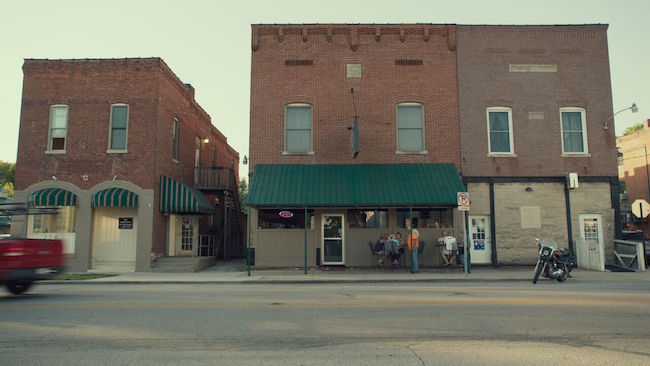Film Review: Stop and Smell (and Watch) the Corn — Fred Wiseman Slows Down in “Monrovia, Indiana”
While nothing happens, there’s an understated splendor in all that’s uneventful here, so much so that I didn’t want to miss any of it.
Monrovia, Indiana, directed by Frederick Wiseman. Screening at the MFA Boston, November 4 through 24.

An action scene from “Monrovia, Indiana.”
By David D’Arcy
What’s slower in pace than a Frederick Wiseman documentary? A Frederick Wiseman documentary about Monrovia, Indiana.
Wiseman’s latest is a visit to Monrovia, a farming community of 1440 souls south of Indianapolis in Mike Pence’s home state. This is a place that voted for Trump in a state that voted for Trump. Monrovia’s business is agriculture and the industry requires fewer people than it once did.
Monrovia is small, and some of its citizens are concerned that its smallness could be a problem in the years to come. This anxiety, expressed by some at a public meeting, is the closest thing to tension that Wiseman’s camera observes.
As for political consciousness, if the name Trump was mentioned, I did not notice. Monrovians seem like people who voted for him instinctively, if not unconsciously. Still, if these farmers earn their living by raising crops that are exported from the US, they could have the same rude awakening that other rural Americans are getting these days.
Judging by Wiseman’s film, things were still rolling smoothly when he shot it. At an auction that’s remarkable for its minimal bidding gestures – even by the standards of farm auctions — a combine sells for $110,000. When the price is called out, there’s barely a reaction from the men in the barn – and yes, it’s only men.
We watch as men operate farm machinery that cut and bale and spit out huge cubes of hay with one person operating a vehicle that has a span of what looks like forty feet. Watch a machine on wheels doing that, and you begin to rethink what the family farm look like today. Mechanization is why some small towns stay small.
Wiseman lingers on people in Monrovia, few as there are. When the drama (such as it is) finishes its course, he lingers on crops in the field. There is not a person out in those fields – no farmworkers, no immigrants. These are not crops that people pick or harvest by hand.
But the people there don’t just farm. They shop at a local gun shop, where most conversations are about the health of this or that friend. They watch a high school band play a vigorous arrangement of the theme from The Simpsons – I guess we should assume that someone in town watches the irreverent TV show. Who knew? And we witness a dutiful veterinarian perform elective surgery, clipping short the tail of a boxer. It’s hard to watch, but it’s as bloody as Monrovia, Indiana gets.

A scene from “Monrovia, Indiana.” Edward Hopper, eat your heart out.
Wiseman cuts away from those scenes to town meetings almost as frequently as he shifts to long shots of corn swaying in the fields, or at least it feels that way. Here we see what quickens the pulse in Monrovia — although no voices are raised. The subject of attracting business to the town comes up. Officials are told that if new housing is built on the outskirts of Monrovia – not that the center of town is so densely settled – new fire hydrants will be needed, which means bringing water to them. Infrastructure costs money. Issue raised, issue tabled. In a compact scene, Wiseman gives us a glimpse of real conservatism: don’t change anything if you don’t need to. And don’t waste time talking about it. This conservatism has nothing to do with Donald Trump.
Conservative doesn’t squash the quirky in Monrovia. To paraphrase Flaubert, to find people odd you just have to look at them long enough. We get a wedding with a special marital cross out of a sci-fi dream (it looks like a flying harness borrowed from Robert Altman’s Brewster McCloud), and a funeral for a woman of 76 with a preacher who seems on a high-test stimulant. Every town has its surprises.
The Masonic Lodge of Monrovia meets. Members wear their aprons and one guy’s many years of participation are honored. If you can’t help but see this gathering as an update (without an ounce of irony) of Jackie Gleason and Art Carney at a lodge meeting in The Honeymooners, you won’t be alone.
Wiseman attends a meeting of another fraternal order in Monrovia, the Lions. They deliberate on where and how to locate a bench near the public library. Given the small-town reluctance to spend money, you can guess what happens. It’s not such a mystery that Main Street in Monrovia looks like a Midwestern version of Edward Hopper’s storefronts. Change costs money.
I would describe myself as a Wiseman fan, but not an absolutist. My recent favorite is In Jackson Heights (2015), which is about the transformation and gentrification of a neighborhood in Queens New York. It’s a poignant evocation of a place that was quickly ceasing to be the place that it was – another version of the contagion in New York that I call death by real estate. The resurgence that some politicians like to talk about tends to price a neighborhood out of the hands of the people who defined its culture. Wiseman gave us that transition, in scene after scene, with character after character, sometimes at a kinetic pace. If you can’t do that in New York, where can you do it?
But his other recent documentary, Ex Libris (2017), about the New York Public Library, surveys that vast institution from room to room without connecting to much – a missed opportunity, considering the library’s tabloid-exposed management dramas and its challenge to address new kinds of literacy and new readers from everywhere in the world. It deserved a penetrating investigation, perhaps in a different style. In Berkeley (2013) suffered from the same problem.
But Monrovia Indiana, respected but not raved about at festivals in Venice and Toronto, revolves around a subject made for Wiseman’s particularly curious and patient observation. I hope those virtues won’t keep people away. While nothing happens, there’s an understated splendor in all that’s uneventful here, so much so that I didn’t want to miss any of it. And Monrovia wasn’t going to speed up for Wiseman or anyone else.
David D’Arcy, who lives in New York, is a programmer for the Haifa International Film Festival in Israel. He reviews films for Screen International. His film blog, Outtakes, is at artinfo.com. He writes about art for many publications, including The Art Newspaper. He produced and co-wrote the documentary, Portrait of Wally (2012), about the fight over a Nazi-looted painting found at The Museum of Modern Art in Manhattan.
